Scottish Folk Tales (Part One)
There are many folk tales from various countries throughout the world, which would often be told as cautionary tales, moral lessons, or just to amuse people in a time before electricity, internet and TV, and when many people could neither read nor afford to buy books in any case. Such tales were a huge part of the social life of people, and in fact still are, although they tend to be directed more at children now, through books and films. But I think most of us have memories of being told or read ‘fairy stories’. So here are some from Scotland. I hope you like them.
THE SHOEMAKER
This is a story from Selkirk. In the distant past most people started work at dawn, and worked from dawn until dusk. This meant that in the winter, working hours could be very short. Where I live in Aberdeenshire at this time of year, it’s too dark to work without light by about 3.30pm, and sunrise isn’t until nearly 9.00am. If you didn’t work, you weren’t paid, so many people would start work before dawn, and work by candlelight. Shoemakers were among these, and this is the tale of a shoemaker.
Early one morning in the winter, a shoemaker was working in Selkirk. His shop was the nearest one to the church, and he was visited while it was still dark by a stranger. The stranger asked for a pair of shoes to be made for him, which were to be delivered at the same early time on a specific day. The shoemaker agreed, made the shoes, and the customer arrived at the right time, paid for the shoes and left with them.
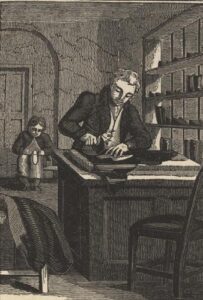
The Shoemaker
Now the shoemaker thought that something about the customer was very strange, and was curious as to where he lived, because he knew everyone in the town, but had never seen this man before, so he decided to follow him, to see where he lived. He set off, keeping a distance so as not to be observed, and was amazed to see his customer go into the graveyard next to the church, and then disappear into one of the graves!
The shoemaker was carrying the awl he used to make his shoes, and, because it was still quite dark, he left the awl on the grave so that he’d know where it was in the daylight. Then he returned when the sun was up with a lot of his neighbours and, taking courage from them, he opened the grave. When he did he found the shoes that he’d made inside the coffin. He probably thought that a dead man could have no use for shoes, so he took them out of the grave, and back home with him.
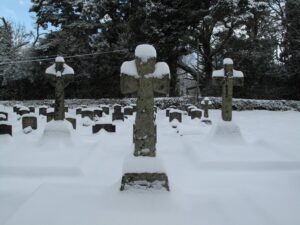
The grave
The next morning he started work before dawn again, and was very busy when suddenly the stranger appeared before him again, and was very angry. The shoemaker was terrified, and all the more so when the stranger told him that he’d not only stolen the shoes that had been paid for, but that he’d made the customer a subject of gossip and wonder by opening his grave, and that the shoemaker would have to pay for this great offence.
So saying, the stranger seized the shoemaker by the arm, and dragged him to the graveyard. Later that day, when the sun had risen, the villagers found the shoemaker’s dismembered corpse on the grave that he’d disturbed on the previous day.
In the past there were many cautionary tales told, to try to deter people from committing crimes. This is a spooky tale probably intended to both entertain people on dark winter nights long before electricity, and to deter people from the dreadful crimes of theft and violating graves!
SAWNEY BEAN
There are a number of Scottish stories about the dreaded cannibal. One of them comes from the coast near Arbroath (not far from where I live), where the coastline is wild and there are a number of caves. It was certainly in print by 1570 that a family of brigands lived in one of the caves, which was called Fiend’s Den. It was said that he used to sneak out and entice children or young men alone to his cave, where he would kill them, and then his family would eat the body. After a while he was discovered and executed for the crime, as was his whole family, except for the youngest daughter, who was only 12 months old. She was brought up by a family in Dundee, but it seems the taste for human flesh was inherited, because when she was an adult, she too was convicted and executed. When she was about to be burnt alive, she informed the crowd that human flesh was so delicious to eat, that if any of the crowd had tried it, they’d never want any other meat either.
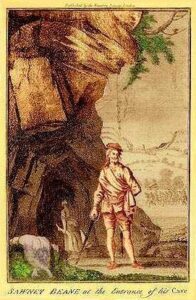
Sawney Bean at the entrance to his cave
This story, which may or may not be true, has probably contributed to the legend of Sawney Bean. He was said to have lived in a cave in the south-west of Scotland, and in common with the tale above, lived with his whole, large family. He was said to rob and kill travellers, who were then cooked and eaten. However, one of the prospective meals succeeded in escaping, and took the authorities to the cave. Stolen goods and money was found there, but also human limbs hung up to dry, and also other human parts that had been pickled. The family was taken to Edinburgh and executed there without the benefit of a trial.
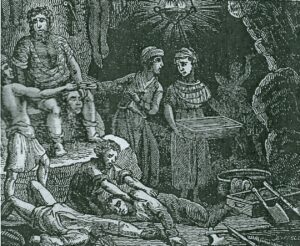
Sawney Bean and his family
There’s no evidence at all that Sawney Bean ever existed, and in fact the story seems to have originated in England rather than Scotland, possibly by Daniel Defoe writing under a pseudonym. He may have been inspired by some mediaeval stories about poor people eating human flesh during famine times. Defoe was an anti-Jacobite, and as the story was published in 1734, it could well have been no more than a piece of anti-Highlander propaganda. Sawney is a short form of Alexander, but ‘auld Sawney’ was also a name for the Devil, and Sawney was also a derogatory term in England for a Scotsman. There were quite a few plays performed in London about Sawney Bean at the beginning of the nineteenth century, but the first telling of the tale by a Scot is not until John Nicholson wrote his Historical and Traditional Tales, in 1843. Wherever it originated, however, it now features in tourist guides of Ayrshire as a gory tale.
A TALE FROM BALLATER
Ballater is about 40 miles away from where I live, so I thought I’d share this tale with you. This particular one wouldn’t have been told round the fire by my MacGregors, because the events are said to have taken place in the nineteenth century. But there are many tales about the same phenomenon, which are much older.
In Ballater there was a family of MacDonalds, who were travellers and lived in a beautiful caravan called the Evening Star. The family consisted of a man, wife and one son, who was already earning money as a trader and hunter by the time he was twelve. One night he’d been out hunting and was tired and a good way from home, when a large coach came along the road, drawn by six white horses. The boy waved to the coach, hoping for a lift, and to his delight it stopped.
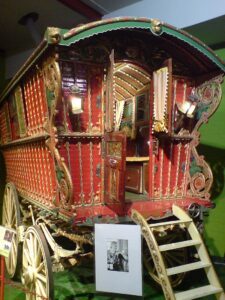
The beautiful caravan (att: By Sunset through the clouds at English Wikipedia, CC BY-SA 3.0, https://commons.wikimedia.org/w/index...)
The coachman was tall and thin, and told the boy that he had to pick up some people along the way, but that the boy could climb up beside him and ride on the outside of the coach if he wanted. The boy agreed, and the coach set off. Along the way they picked up a number of passengers, including an old man, a beautiful girl and a woman in a white gown. The MacDonald boy, being friendly, said good evening to them as they got into the coach, but none of them replied, and none of them spoke to the other passengers or the coachman either.
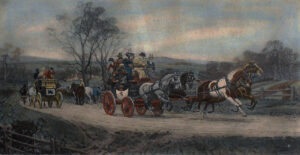
The coach and horses
After a time they stopped at a house, and the coachman said they would have to wait for a while, because he was early, so the boy, who was feeling cold by now, decided to sit inside the coach for a short while to warm up a bit. But when he got in the coach he immediately felt very uncomfortable, because all the passengers were glassy-eyed and silent, which made him think the coachman was maybe on his way to a lunatic asylum with them all. He got out again, and as it was now raining, decided to shelter under the eaves of the house that the coachman had gone into.
While he was there, he looked in the window, to see an old man lying on the bed. A woman and a minister were there too, and the boy heard the minister say that the man had died. The boy’s sadness turned to horror when he saw the coachman walk into the room and wave his hand, whereupon the corpse got up from bed and walked out to the carriage. The boy now realised that the coachman was Death. Death had told the boy that his next stop was in Ballater, where the boy lived, but as he was now terrified, he asked to get out before they reached the village. As he got down, he asked the coachman where the next stop was. The man replied that it was at the Evening Star, and then drove off.
Realising that this was his parents’ caravan, the boy ran as fast as he could to try to warn them, but when he got in sight of it, he could see that it was on fire. He began to cry, thinking he was now surely an orphan, but then saw his mother and father coming to meet him. Relieved, he told them what had happened, and wondered why Death had said he was coming to them, when they were alive. His mother replied that sadly their little dog had died in the fire, so maybe Death had come for him instead.
If you liked these, look out for my next blog, which will feature three more Scottish Folk Tales, about a White Lady, a cave devil, and changelings!



